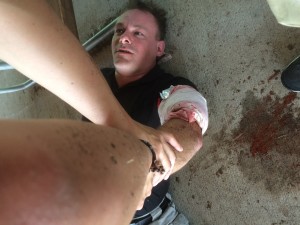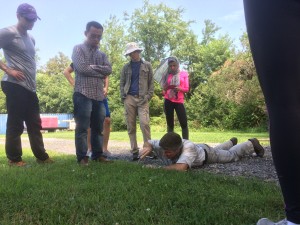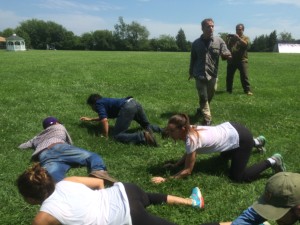Our group of journalists was separated into two units and positioned in different vehicles. The road to our destination is full of danger, we were told, but our drivers and fixers were experienced in handling hostile situations. Along the path we heard intermittent gunshots. An ongoing feeling of being watched crossed my mind. Then, our driver hit the breaks and I saw the threat up ahead. Two convoys were blocking the dirt road and a group of AK-47-wielding men pointed their weapons at us, screaming. They take our passports and money, beat one of our drivers to death and leave us running in a conflict zone dodging bullets, trying to avoid land mines and tending to injured colleagues.

A scenario during training that recreates a surprise gunfire attack with several casualties in need of first aid assistance. (Mathias Meier/MEDILL)
Fortunately the situation described above is only a make-believe hostile environment setting established to train journalists in how to cover stories in the world’s most dangerous conflict zones. The moment, however, is incredibly real and often traumatic. You are put under pressure, interrogated, yelled at, blindfolded and kept in captivity. Without undergoing that instant when you become a hostage – a pawn in the game of war between sides you don’t even represent – you can’t truly comprehend what other fellow colleagues have experienced for real.
“You wouldn’t send soldiers to war without proper training. That would be highly irresponsible. And it should be considered irresponsible to send out journalists to cover war without proper training too,” says Frank Smyth, founder and executive director of Global Journalist Security, the organization that led the training we underwent during two days in July. “I don’t think anybody argues that our training is and it’s a necessary prerequisite to skillfully cover conflicts around the globe.”
Global Security Journalism was founded in 2011. During the early years they trained mostly NGO workers. Today, 60 percent of the people attending their courses are journalists. “It seems that this number is constantly going up. Last year we trained around 200 people. This year we will get closer to 500, and we do not only train here. We have experience training women in Africa and are also expanding to Latin America, specifically Mexico and Colombia,” explains Smyth.
The pen is mightier than the sword
During the exhaustive training my Medill colleagues and I underwent, the memory of James Foley and the decision about whether to risk your life for a story crossed my mind many times. Just about a month before I came to the U.S., Foley was killed by a then almost unknown Islamic State. As a journalism martyr and Medill graduate, his image was very present during my first months of class.
Smyth shows a picture of him at the beginning of one his presentations. This happens just moments before, in a role-playing situation, strangers put a bag over our heads and threaten to kill us. “It’s a cautionary tale. He was trying to do the right thing and he was trying to be smart about it. But what we learn is that what seems to be safe today becomes unsafe tomorrow… without warning,” he explains.
Smyth himself is no stranger to the dangers of covering war. “My Iraq experience was a tragedy, a tragedy of unspeakable events and consequences,” he recalls. “But at least it made me much more security-conscious. Much more than I’d ever been before.”
In 1991, along with two partners, Smyth went missing for 18 days after being captured by Iraqi forces while covering the aftermath of the Gulf War. “It took me a long time to get over the PTSD from that. Two colleagues were killed. It’s very common for young freelancers who survive these kinds of experiences to go through this.”

Paul Burton, a former British Army Sergeant Major in the elite 148 Commando unit, explains how to detect different types of land mines. (Mathias Meier/MEDILL)
Unlike Smyth, Foley didn’t come back to tell the story. He is now an example of why risking your life to shed light on injustices and stories that go untold might just not be worth it. But I still believe in one thing, and this is something you learn once you start publishing and seeing the power your craft carries: the pen will remain mightier than the sword. It ultimately gives a voice to the voiceless and brings change. And that is the romantic, but proven, ideal behind the motivation of many professionals that decide to risk everything and go cover an armed conflict.
“No story is worth dying for,” states Smyth. “I reject that mantra. It’s misleading. What it presumes is that if you survive, you did it right, and if you don’t survive, you did it wrong. And that is a complete myth. Yes, if you do things right you will reduce your chances of injury, death and tragedy. But there’s no guarantee of it. So, of course no story is worth dying for. The question is: is it worth the risk?”
I’ve been asking myself that question lately. And I’ve been asking it to many of my experienced colleagues who have been there, in the front lines, risking it. Their answers often times seem a bit text book: “Someone has to do it” or, “It’s our duty.” Others gave me more uplifting ones: “We can’t abandon the victims” and, “Our stories bring justice to forsaken places.” Some told me that it’s an improper question, or worse, an insult to mates who are still risking their lives to be able to tell about the harsh reality of war.
The good thing is none of them told me that it isn’t worth it. And I like that thought.

Former Canadian Army soldier, combat medic and medical training supervisor Jean-François Belzil teaches how to avoid enemy gunfire in a hostile environment. In the back is Frank Smyth. (Mathias Meier/MEDILL)





